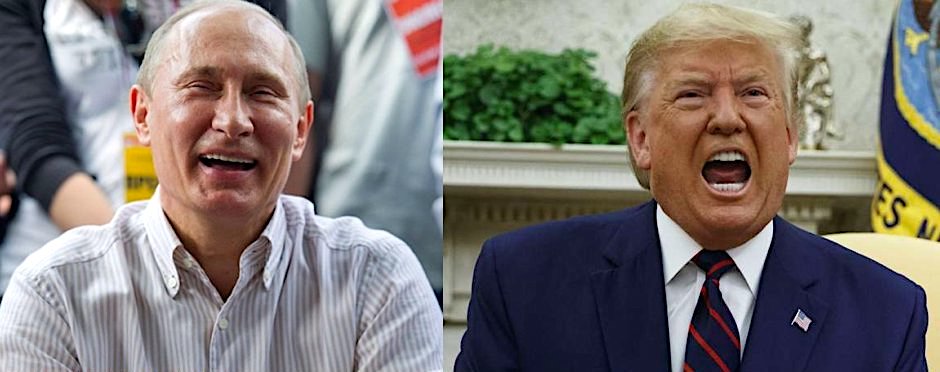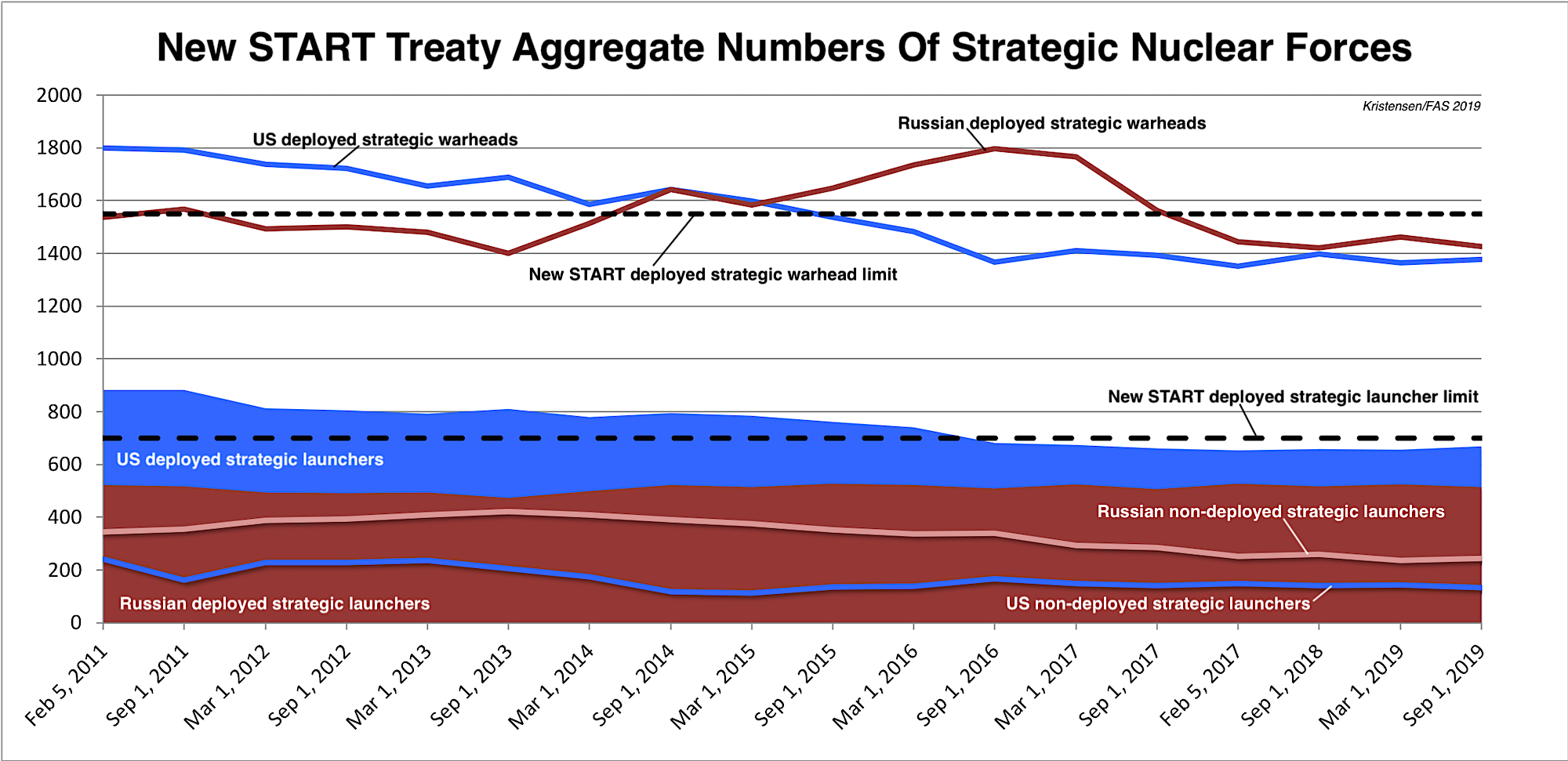
New START Treaty Data Shows Treaty Keeping Lid On Strategic Nukes
The latest data on US and Russian strategic nuclear forces limited by the New START treaty shows the treaty is serving its intended purpose of keeping a lid on the two countries’ arsenals.
The data was published by the State Department yesterday.
Despite deteriorating relations and revival of “Great Power Competition” strategies, the data shows neither side has increased deployed strategic force levels in the past year.
The data set released is the last before the New START treaty enters its final year before it expires in February 2021. The treaty can be extended for another five years by the stroke of a pen, but arms control opponents in Washington and Moscow are working hard to prevent this from happening. If they succeed, the world’s two largest nuclear arsenals will be completely unregulated for the first time since the 1970s.
By The Numbers
The latest data shows that the United States and Russia combined, as of March 1st, 2019, deployed a total of 1,181 strategic launchers (long-range ballistic missiles and heavy bombers) with a total of 2,802 warheads attributed to them (see chart below). That is very close to the combined forces they deployed six months ago. These two arsenals constitute more strategic launchers and warheads than all the world’s other seven nuclear-armed states possess combined.
For Russia, the data shows 513 deployed strategic launchers with 1,426 warheads. That’s a slight decrease of 11 launchers and 3 warheads compared with March 2019. Russia is currently 187 launchers and 124 warheads below the treaty limit for deployed strategic weapons.
The United States deploys 668 strategic launchers with 1,376 warheads attributed to them, according to the new data, or a slight increase of 12 launchers and 11 warheads compared with March 2019. The United States is currently 32 launchers and 174 warheads below the treaty limit for deployed strategic weapons.
These increases and decreases since March 2019 are normal fluctuations in the arsenals due to maintenance and upgrades and do not reflect an increase or decrease of the force structure or threat level.
It is important to remind, that the Russian and US nuclear forces reported under New START are only a portion of their total stockpiles of nuclear weapons, currently estimated at 4,330 warheads for Russia and 3,800 for the United States (6,500 and 6,185, respectively, if also counting retired warheads awaiting dismantlement). Both sides could upload many hundreds of warheads extra on their launchers if New START was allowed to expire.
Build-Up, What Build-Up?
Both Russia and the United States are engaged in significant modernization programs to extend and improve their strategic nuclear forces. So far, however, these programs largely follow the same overall structure and are unlikely to significantly change the strategic balance of those forces. The New START data shows the treaty is serving to keep a lid on those modernization plans.
That said, both countries are working on modifications to their strategic nuclear arsenals. Russia has been working for a long time – even before New START was signed – to develop exotic intercontinental-range weapons to overcome US ballistic missile defense systems. These exotic weapons, which are not yet deployed or covered by the treaty, include a ground-launched nuclear-powered cruise missile (Burevestnik) and a submarine-launched torpedo-like drone (Poseidon). The Trump administration is complaining these new weapons should be included in the treaty. A third weapon, an ICBM-launched glide-vehicle commonly known as Avangard, is close to initial deployment and will be accountable under the treaty but would likely replace existing deployed warheads. All of these weapons are limited in numbers and insufficient to change the overall strategic balance or challenge extension of New START. The treaty provides for adding new weapon types if agreed by the two parties, although neither side has formally proposed to do so.
Russia is not at an advantage in terms of overall strategic nuclear forces and the new data shows it does not appear to try to close the significant gap that exists in the number of deployed strategic launchers – 155 in US favor by the latest count (up 23 launchers from March 2019). To put things in perspective, 155 launchers are the equivalent of an entire US ICBM wing, or more than seven Ohio-class ballistic missile submarines fully loaded, or more than twice the size of the entire US nuclear bomber fleet. If the tables were turned, US officials and hardliners would certainly be complaining about a Russian advantage. Given this launcher disparity, one could also suspect that Russia might seek to retain more non-deployed launchers for potential redeployment to be able to rapidly increase the force if necessary. Instead, the New START data shows that Russia has continued to decrease its non-deployed launchers (down 12 since March 2019).
Instead of trying to close the launcher gap, Russia is compensating for the disparity by maximizing warhead loadings on its new missiles to be able to keep overall parity with the United States. Since 2016, the New START data indicates that Russia has been forced to reduce the normal warhead loading on some of its ballistic missiles in order to meet the treaty limit for deployed warheads. This demonstrates New START has a real constraining effect on Russian deployed strategic forces.
Having said that, Russia could potentially – like the United States – upload large numbers of non-deployed nuclear warheads onto deployed strategic launchers if a decision was made to break out of the New START limits or the treaty was allowed to expire in 2021. Those launchers would include initially bombers, then sea-launched ballistic missiles, and in the longer term the ICBMs. Significantly increasing the force structure, however, would take decades to achieve because both sides have based their long-term planning on the assumption that the New START force level would continue.
The United States has dismantled and converted more launchers than Russia because the United States had more of them when the treaty was signed, not because Washington was handed a “bad deal,” as some defense hardliners have claimed. But Russia has complained – including in an unprecedented letter to the US Congress – that it is unable to verify that launchers converted by the US to a conventional role cannot be returned to nuclear use. The New START treaty does not require irreversibility, however, and the US insists the conversions have been carried out in accordance with the treaty provisions that Russia agreed to when it signed the treaty.
The Russia complaints about converted launchers and the US complaints about incorporating new strategic weapons are issues that should be resolved in the treaty’s Bilateral Consultative Committee (BCC).

The US complains new Russian strategic weapons should be included in New START and Russia complains it can’t verify irreversibility of converted US launchers
Verification and Notifications
Although not included in the formal aggregate data, the State Department has also disclosed the total number of inspections and notifications conducted under the treaty. Since February 2011, this has included 313 onsite inspections (25 this year) and 18,803 notifications (2,387 last 12 months). This data flow is essential to providing confidence and reassurance that the strategic force level of the other side indeed is what they say it is. It also provides each side invaluable insight into structural and operational matters that complements and expands what is possible to ascertain with national technical means.
What Now?
Although bureaucrats and Cold Warriors in both Washington and Moscow currently are busy raising complaints and uncertainties about the New START treaty, there is no way around the basic fact: New START is strongly in the national security interest of both countries – as well as that of their allies.
But the treaty expires in February 2021 and the two sides could – if their leadership was willing to act – extend it with the stroke of a pen.
Unfortunately, Russian complaints that it is incapable of confirming US conversion of strategic launchers, US complaints that new exotic Russian weapons circumvent the treaty, Russia’s violation and the US decision to withdraw from the INF treaty, as well as the growing political animosity and bickering between East and West, have combined to increase the pressure on New START and put extension in doubt.
This all captures well the danger of Cold War mindsets where nationalistic bravado and chest-thumping override deliberate rational strategy for the benefit of national and international security. Bad times are not an excuse for sacrificing treaties but reminders of the importance of preserving them. Arms limitation treaties are not made with friends (you don’t have to) but with potential adversaries in order to limit their offensive nuclear forces and increase transparency and verification. If officials focus on complaining and listing problems, that’s what they’ll get.
It is essential that Russia and the United States decide now to extend the New START treaty. Without it, the two sides will switch into a worst-case-scenario mindset for long-term planning of strategic forces that could well trigger a new nuclear arms race.
Additional information:
- FAS Nuclear Notebook: Russia nuclear forces, 2009
- FAS Nuclear Notebook: US nuclear forces, 2019
- Status of world nuclear forces
This publication was made possible by generous contributions from the Carnegie Corporation of New York, the John D. and Catherine T. MacArthur Foundation, the New Land Foundation, the Ploughshares Fund, and the Prospect Hill Foundation. The statements made and views expressed are solely the responsibility of the authors.
This report outlines a framework relying on “Cooperative Technical Means” for effective arms control verification based on remote sensing, avoiding on-site inspections but maintaining a level of transparency that allows for immediate detection of changes in nuclear posture or a significant build-up above agreed limits.
The grant comes from the Carnegie Corporation of New York (CCNY) to investigate, alongside The British American Security Information Council (BASIC), the associated impact on nuclear stability.
Satellite imagery of RAF Lakenheath reveals new construction of a security perimeter around ten protective aircraft shelters in the designated nuclear area, the latest measure in a series of upgrades as the base prepares for the ability to store U.S. nuclear weapons.
It will take consistent leadership and action to navigate the complex dangers in the region and to avoid what many analysts considered to be an increasingly possible outcome, a nuclear conflict in East Asia.
